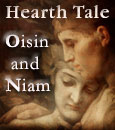|



Stay up to date on the latest sites featuring
Irish historical and cultural themes!
Request
your
free newsletter!




|
  Being
a traditional name of great age, there are numerous accounts for the linguistic
origin of Éire. In the early Irish manuscripts the variant of Ériu was
commonly used. The contemporary name is a later Anglo hybrid, setting
the island as the 'land of Éire.' It serves as an appropriate reference,
for in ancient mythology, Éire is one of a trinity of goddesses who represent
the personification of the island itself. Being
a traditional name of great age, there are numerous accounts for the linguistic
origin of Éire. In the early Irish manuscripts the variant of Ériu was
commonly used. The contemporary name is a later Anglo hybrid, setting
the island as the 'land of Éire.' It serves as an appropriate reference,
for in ancient mythology, Éire is one of a trinity of goddesses who represent
the personification of the island itself.
 |
Ireland
is the westernmost country of within the European Union. The island
nation is separated from Great Britain by the North Channel on the
northeast and the Irish Sea on the east. Total coastline measures
1,448 km. |
The Republic of Ireland consists of Connaught, Leinster, and Munster provinces,
totaling 23 counties, and in the north, 3 counties of Ulster Province. Northern
Ireland consists of 26 districts, the remainder of Ulster Province.
National capital: Dublin
Primary cities by population: Dublin; Cork;
Limerick; Galway; Waterford.
Ports and harbors: Arklow, Cork, Drogheda, Dublin,
Foynes, Galway, Limerick, New Ross, Waterford
Climate: temperate maritime; modified by North
Atlantic Current; mild winters, cool summers; consistently humid; overcast about
half the time.
Terrain: mostly level to rolling interior plain
surrounded by rugged hills and low mountains; sea cliffs on west coast
Population: 3,619,480
Age structure: 0-14 years:
22%
15-64 years: 67% - 65 years and
over: 11%
Population growth rate: 0.36%
(Estimates are current to July 1998.)
Ethnic groups: Celtic, English
Religions: Roman Catholic 93%, Anglican 3%,
none 1%, unknown 2%, other 1% (1981)
Languages: Irish (Gaelic), spoken mainly in
areas located along the western seaboard, English is the language generally used
 |
The
Irish flag consists of three color fields of equal share in a vertical
pattern. |
The design dates to the mid nineteenth century, it became
widely accepted after its use in the Easter Rising of 1916. The green field represents
the majority Catholic population. The orange field represents the Protestant population,
bearing the colors of William of Orange. The white field represents the promise
of a sustaining peace between the two.
Independence: 6 December 1921
Constitution: 29 December 1937; adopted 1 July
1937 by plebiscite. A full
text of the Irish constitution, Bunreacht Na hÉireann, is provided on-line
by the Irish government.
A primary source of information for this page is the Central Statistics Office (CSO)
for Ireland. In depth resources are available on-line regarding all essential indicators.

Stay up to date on the latest sites featuring Irish historical and cultural themes!
Request
your free newsletter!
|
|

Regional Index:
Together, Northern Ireland and the Republic
are comprised of four provinces, which consist of thirty two counties.


 Galway
Galway
 Leitrim
Leitrim
 Mayo
Mayo
 Roscommon
Roscommon
 Sligo
Sligo


 Carlow
Carlow
 Dublin
Dublin
 Kildare
Kildare
 Kilkenny
Kilkenny
 Laois
Laois
 Longford
Longford
 Louth
Louth
 Meath
Meath
 Offaly
Offaly
 Wicklow
Wicklow
 Wexford
Wexford
 Westmeath
Westmeath


 Clare
Clare
 Cork
Cork
 Kerry
Kerry
 Limerick
Limerick
 Tipperary
Tipperary
 Waterford
Waterford


 Antrim
Antrim
 Armagh
Armagh
 Cavan
Cavan
 Down
Down
 Derry
Derry
 Donegal
Donegal
 Fermanagh
Fermanagh
 Monaghan
Monaghan
 Tyrone
Tyrone
The counties of Cavan, Donegal and
Monaghan although part of the Republic of Ireland since 1922,
have traditionally belonged to Ulster Province.
 The
country is also commonly divided up informally as North, East, South, West, Northwest
and the Midlands. The
country is also commonly divided up informally as North, East, South, West, Northwest
and the Midlands.

|



